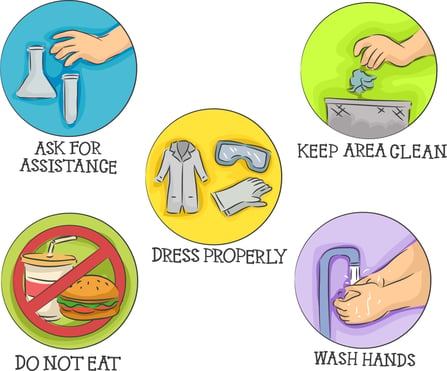
5 Easy Math Engagement Strategies for the Classroom
The news headlines are daunting. Math scores are down. School districts are scrambling to turn things around. And...
ALI Staff | Published September 19, 2023
As a lab teacher, you never have to question the importance of following laboratory safety guidelines. You are well aware of the necessity of these rules and the potential consequences of disregarding them.
However, your students may not fully grasp the significance.
Safety rules exist for a reason, and it is crucial to ensure that your students understand and adhere to them to maintain a safe and productive lab environment.
Read on to learn about good lab practices and safety guidelines that should never be ignored in your lab.

The reason lab safety rules are important is in their very name — they exist to keep students safe.
The lab environment is unlike anything students see elsewhere, from dangerous chemicals to the risk of equipment breaking or injuring a student if misused.
The materials are different, and so are the risks.
Lab rules can vary between schools and even between subjects, but establishing a solid set of rules for your lab is always a must.
You must also review your rules with your students at the start of the year and periodically throughout.
Certification and training are crucial for maintaining a safe and productive lab environment.
By reducing hazards and risks associated with Science, STEM, CTE, and lab programs, you can improve safety policies and minimize the potential for injuries and lawsuits in your school or district.
Utilizing scalable safety technology, online safety training, and expert safety services and resources will enhance the overall lab experience and ensure all lab participants' well-being.
Attending training, getting certified, and consistently updating your knowledge and practices are essential to creating a safer lab environment.
There are certain universal safety rules all lab teachers can adopt into their class-specific list.
Even if these feel like common sense safety protocols to you, never assume your students know this information in advance.
Good lab practices come about because you provide students with a foundational understanding of lab safety, so starting with the basics is often helpful for students.
Some general lab safety rules to consider using in your class:
Review the evacuation procedure from the lab with students as well and spend some time pointing out where the first aid kit, fire extinguishers, eyewash station, and safety shower (if applicable) are.
Walk students through how to use the eyewash and shower in an emergency as an additional part of your general lab safety rules.
Lastly, but of equal importance, don’t forget to review the signs and symbols around the lab.
Students should understand what they all mean, whether they’re pointing out something hazardous or not.
Keeping students safe in the lab also means thinking about what they wear during lab. Safety rules should include information about the proper attire. Each lab should begin with instructions on what students must wear for the activity.
For those with long hair, it means pulling it back during lab time. Caution students against loose clothing and dangling jewelry and always require closed-toe shoes in the lab.
The proper safety gear, like goggles, gloves, and lab coats, should always be available to students as part of their lab attire.
Another part of your general rules should include housekeeping items like keeping your work area clean and tidy.
This list of safety rules should remind students that only the items they need for the lab that day belong on their table and that certain items have unique disposal procedures that must be followed.
On your end, some housekeeping items to consider include checking air flow and ventilation in the lab and ensuring items are stored properly, with heavier items on the bottom shelves and lightweight items on top.
Lab safety in chemistry is a bit different.
There are many more hazardous items in a chemistry lab and a lot more risk if these items aren’t used correctly.
For these reasons, the most significant lab safety rule in chem is to treat every chemical as if it were harmful. Of course, everything should be clearly labeled, but being extra careful is never a bad thing.
Other rules to share with your chemistry students can include:
You’ll also want to walk students through how to clean up a chemical spill, whether the chemical is acidic or alkaline while making it a staunch rule that any spill must be cleaned up immediately.
No matter what you do, the list of lab safety rules will feel long to students. There’s a lot to know to avoid hazards and injuries in a lab because it’s unlike any other place around school they'll be in.
So, go through that long list and enforce the rules often. Lab safety and good lab practices can never be reiterated too much.

The news headlines are daunting. Math scores are down. School districts are scrambling to turn things around. And...

Math assessment in California is changing. What used to be a compliance exercise or reporting tool is now becoming a...

You know the moment: a student’s eyes light up when the science experiment fizzes or the math puzzle helps them...